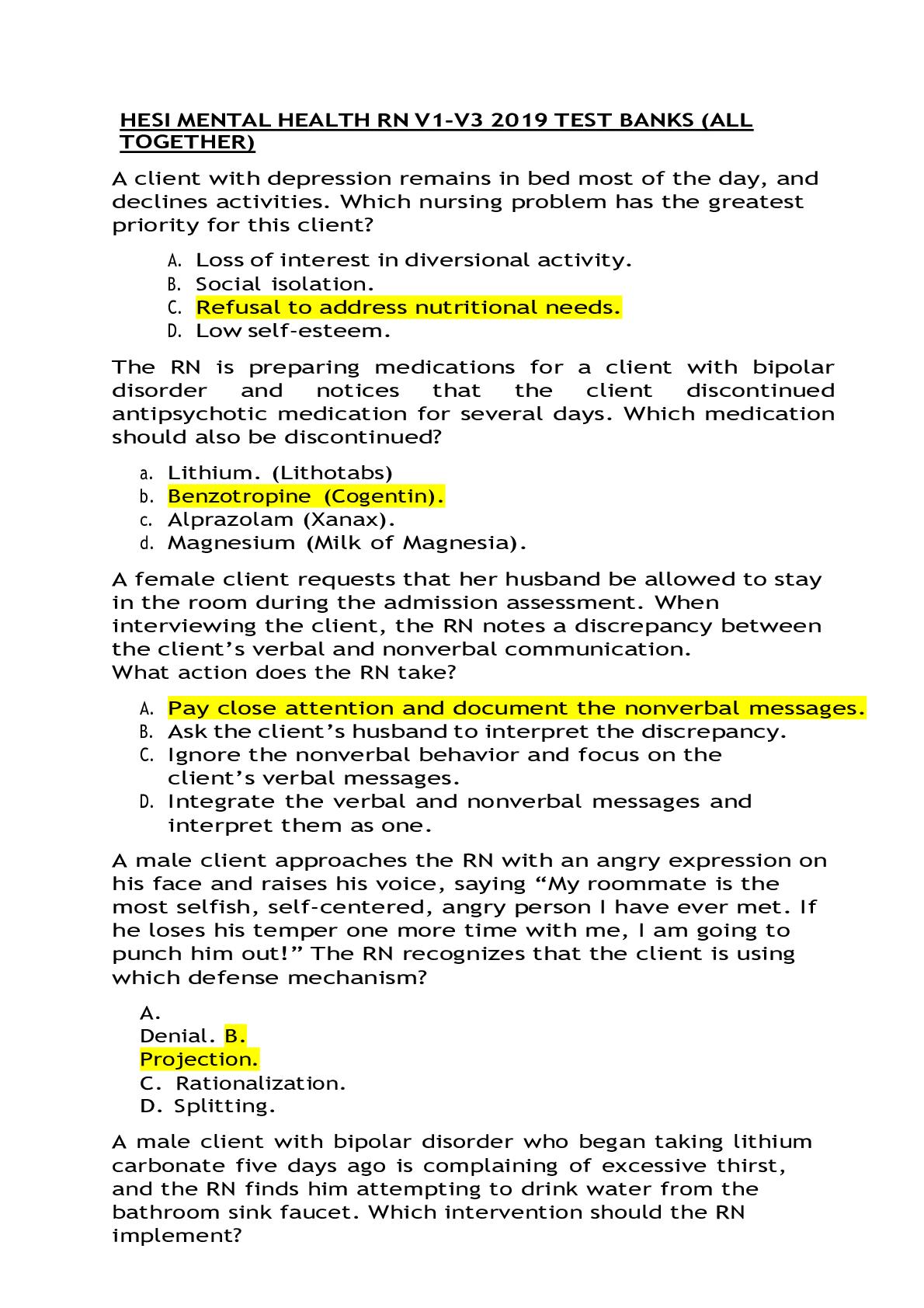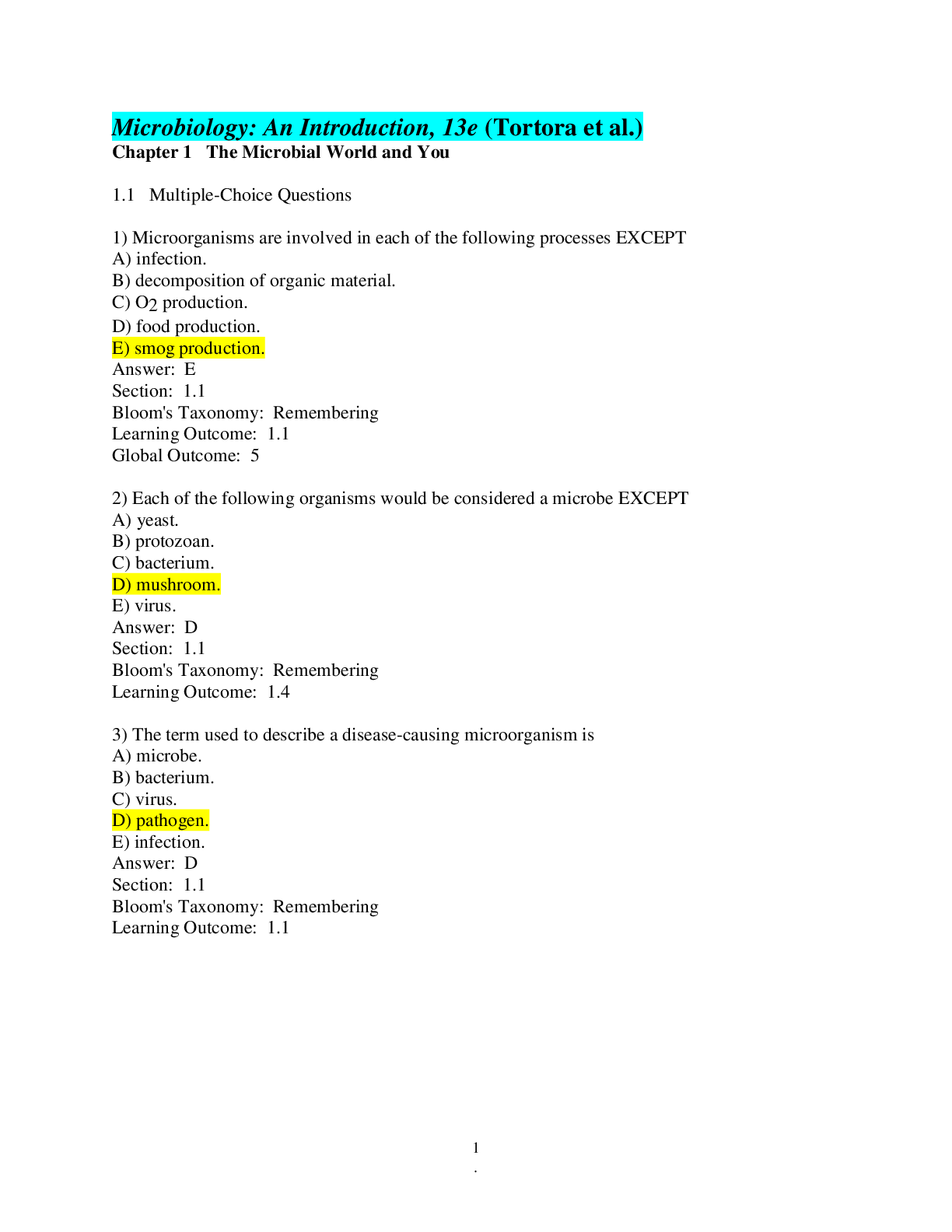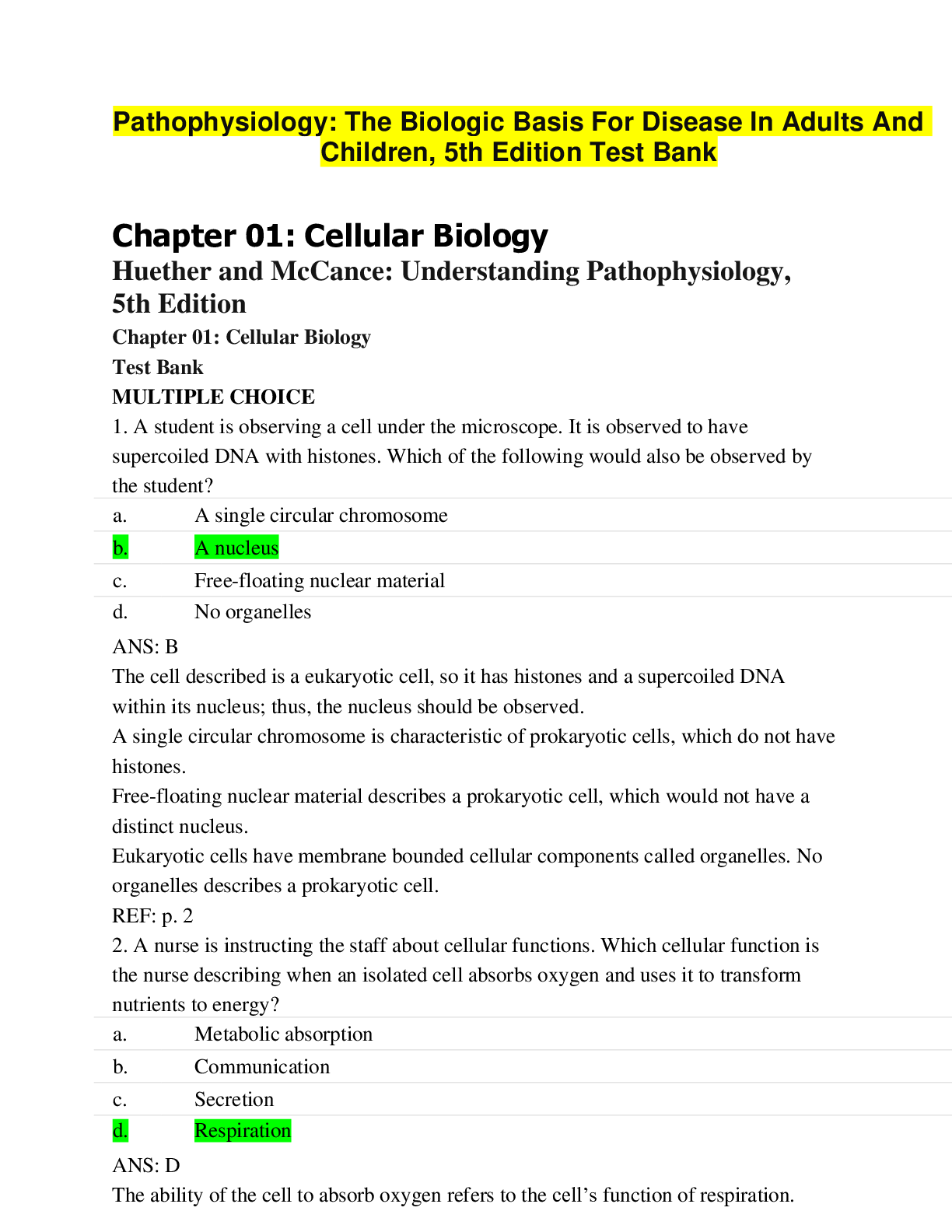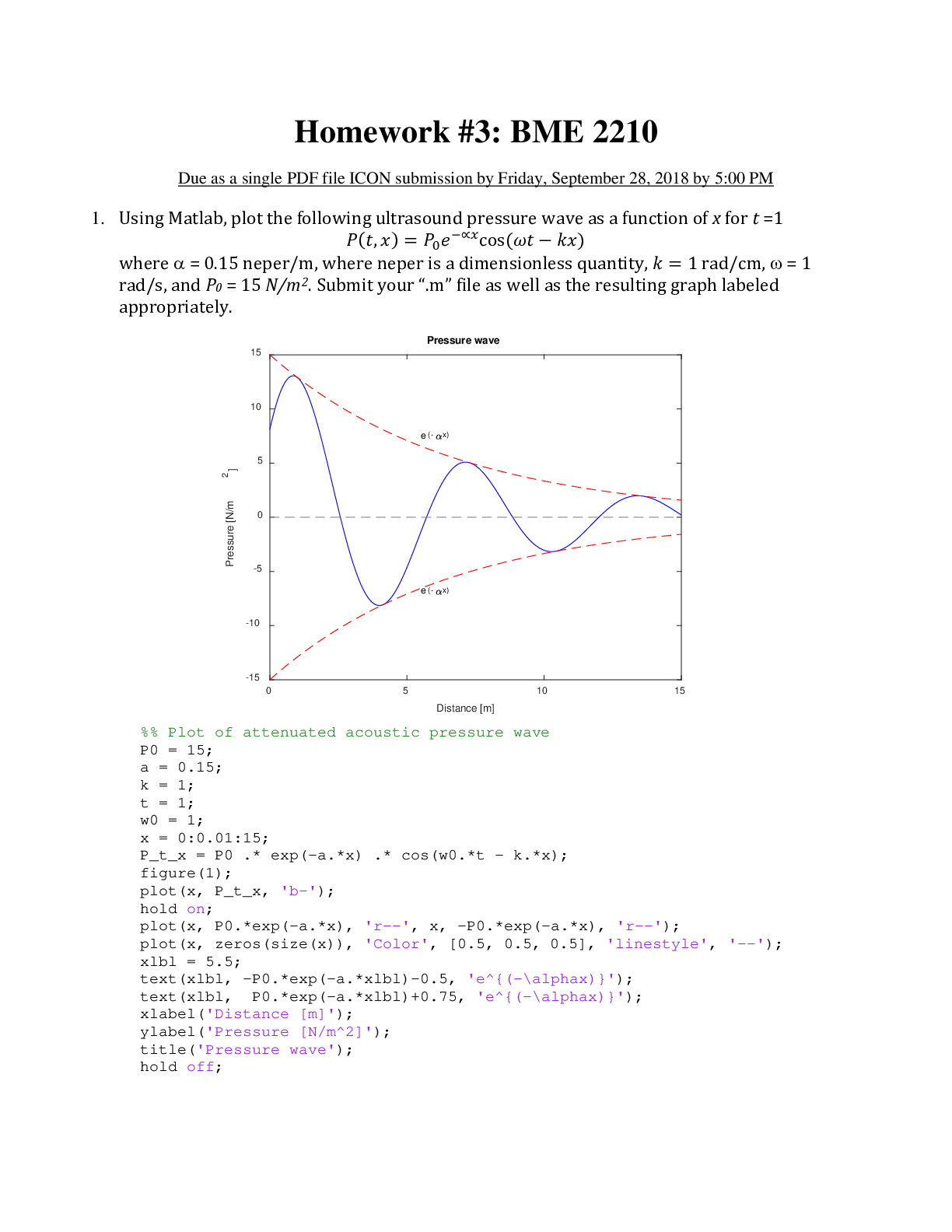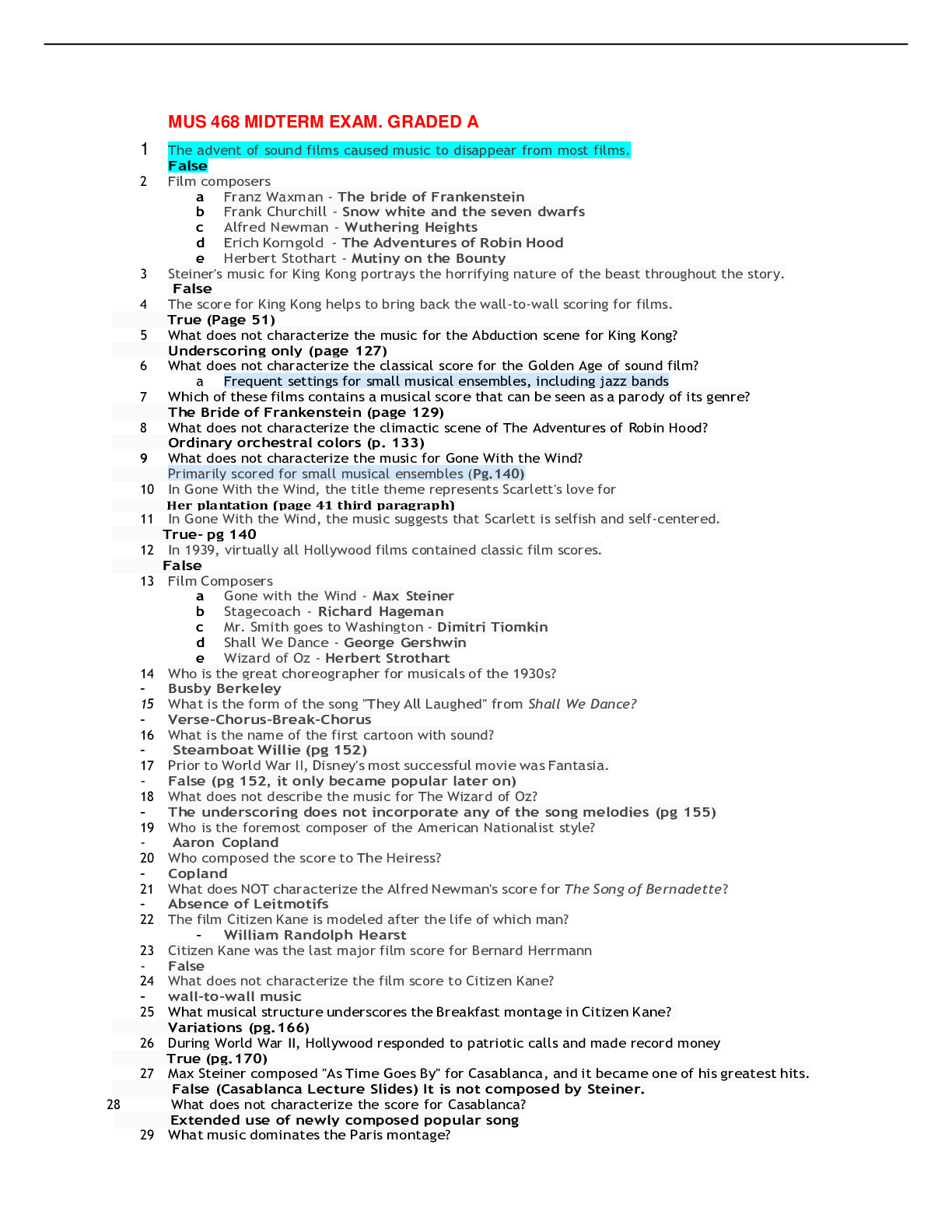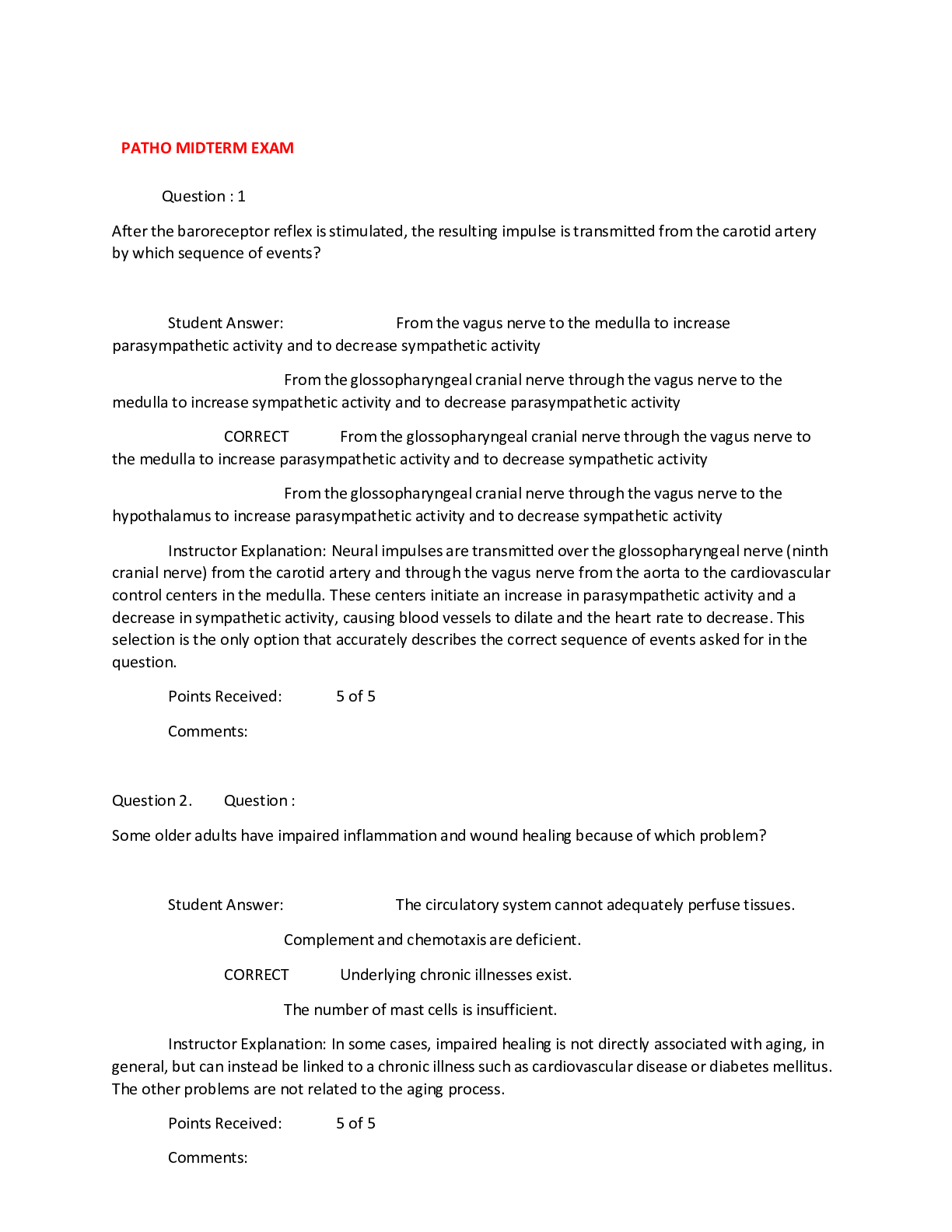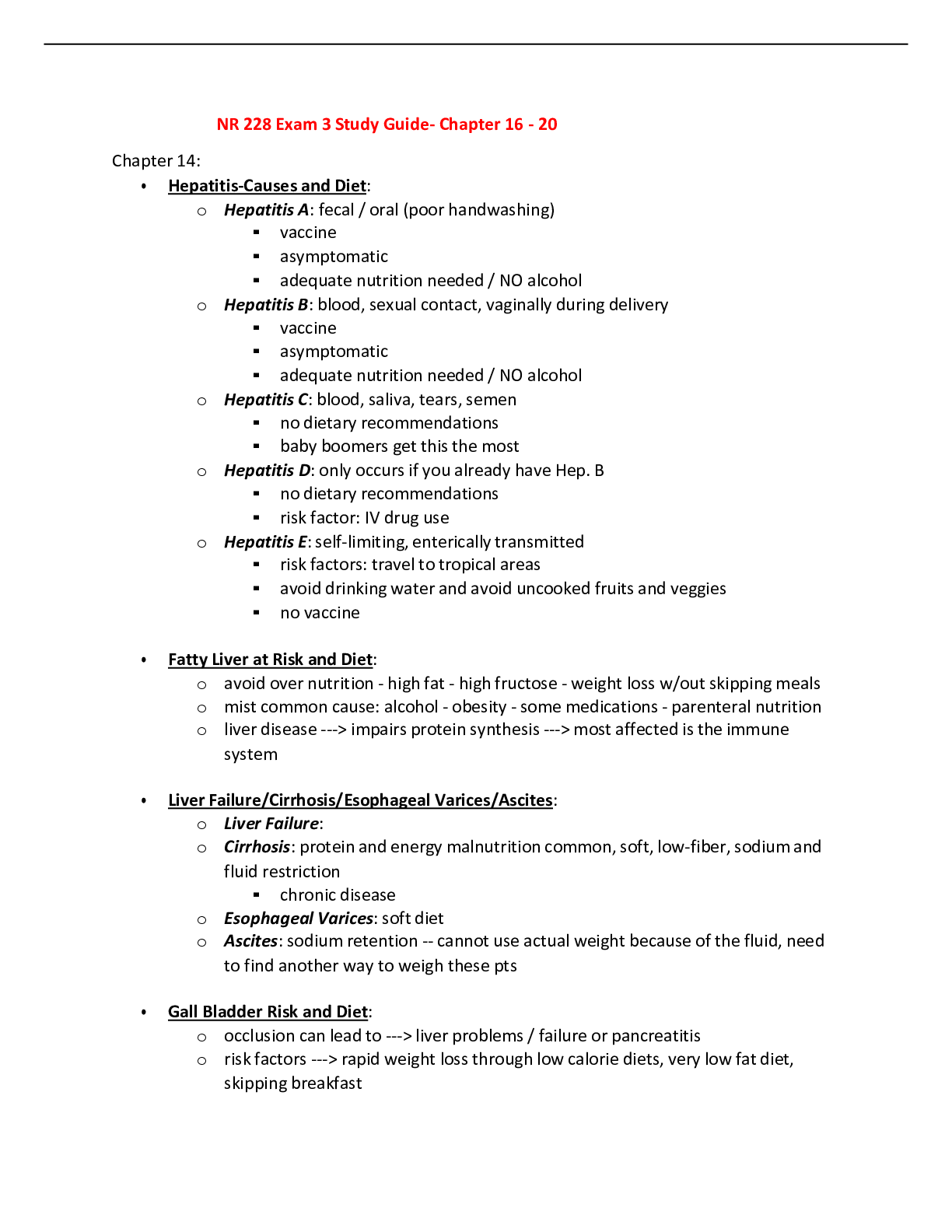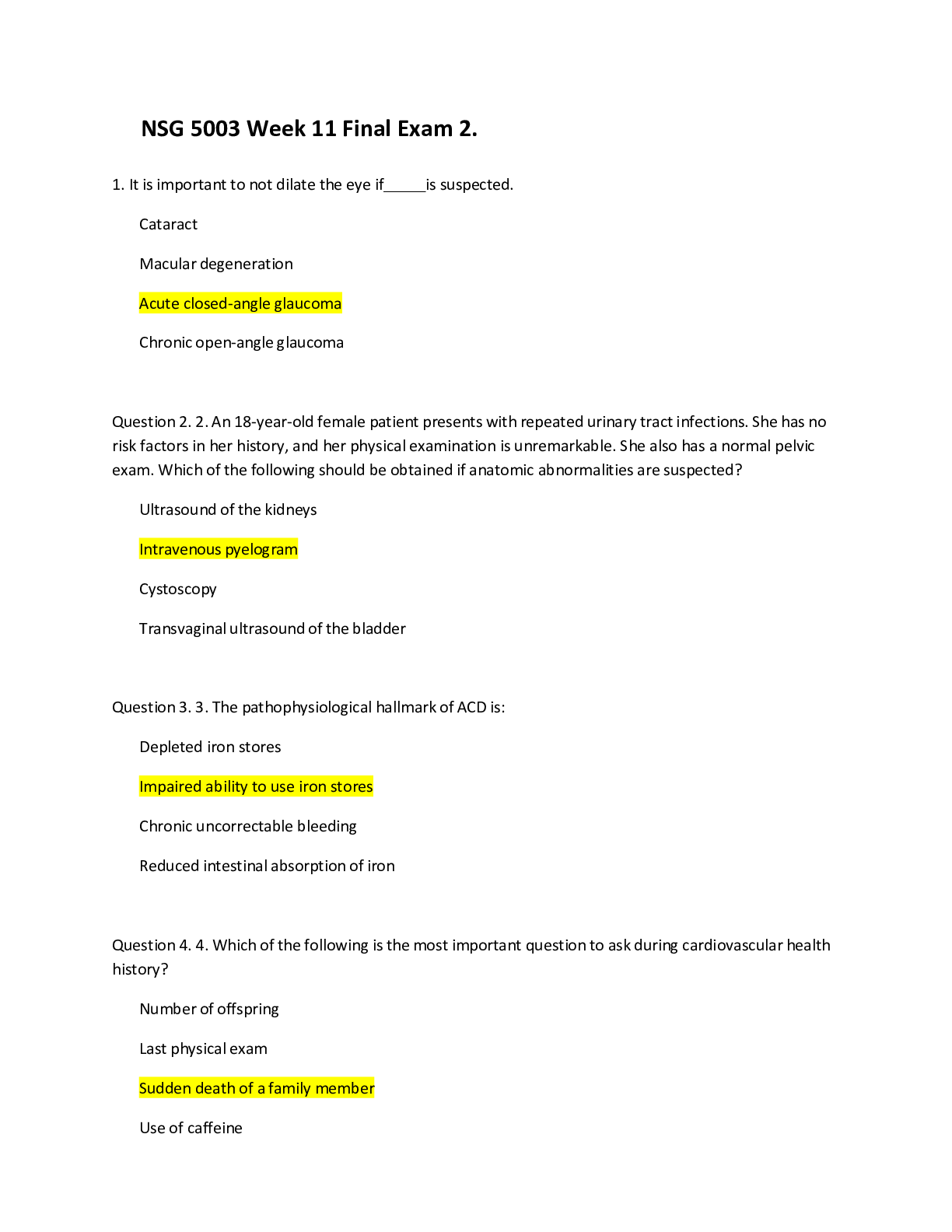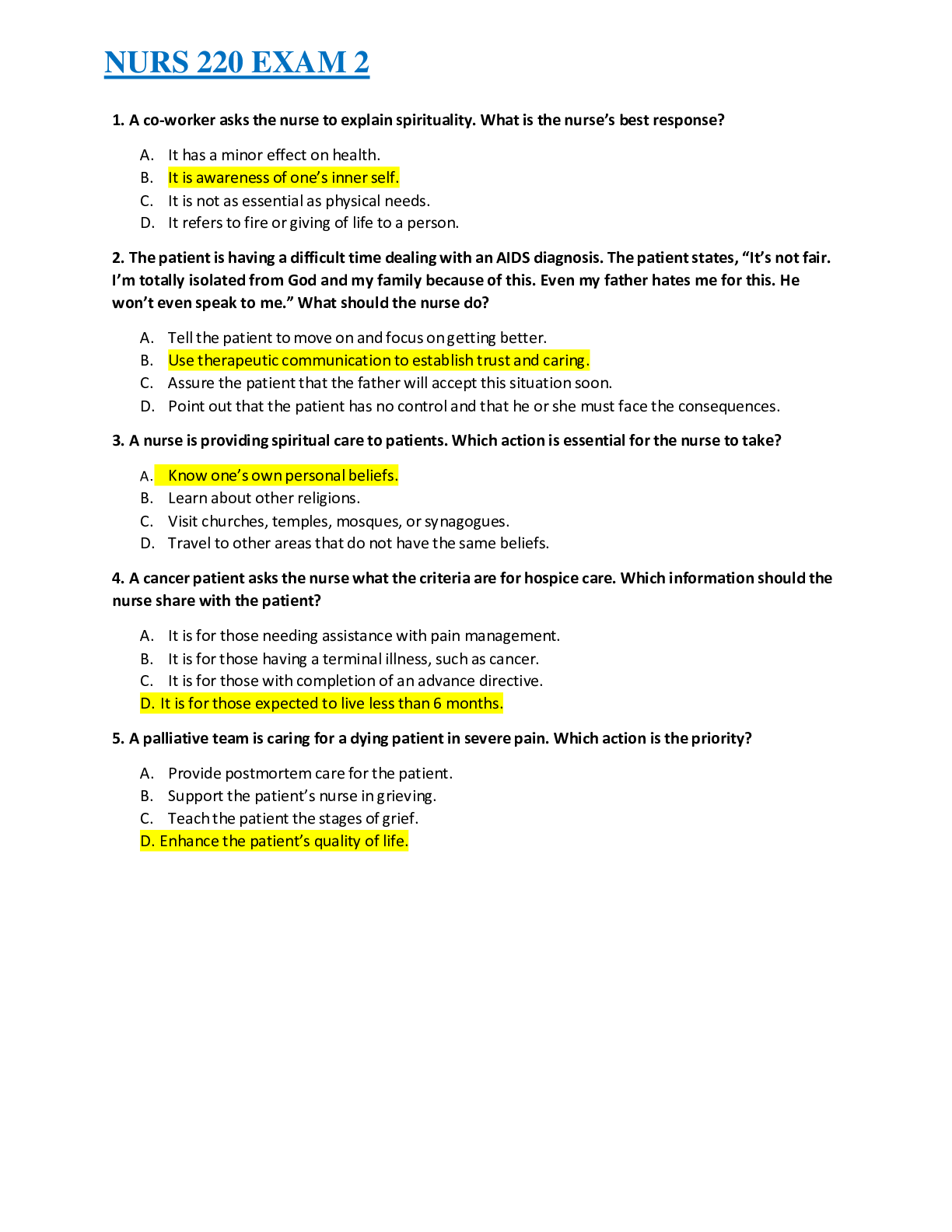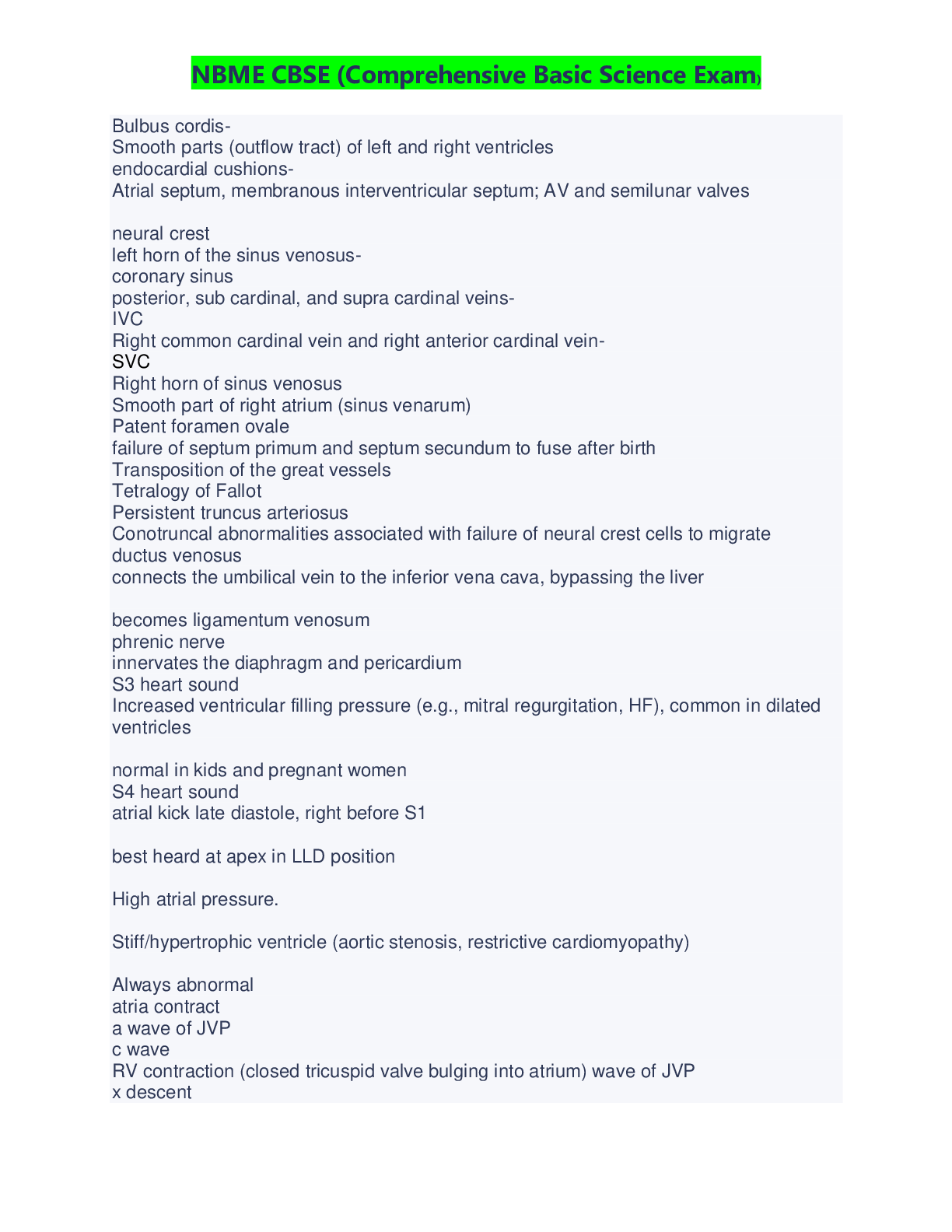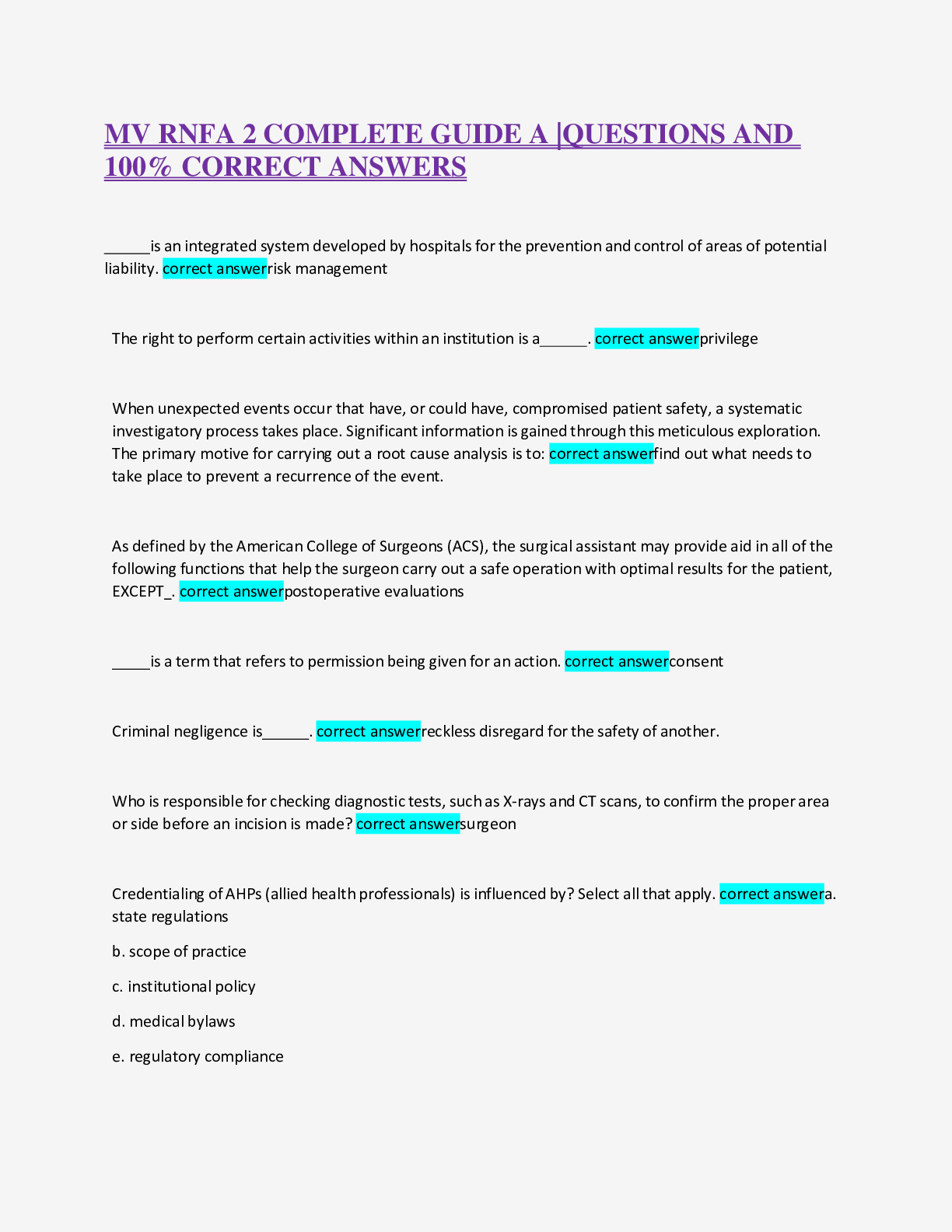Financial Accounting > EXAM > ACCT Exam 2 complete guide (All)
ACCT Exam 2 complete guide
Document Content and Description Below
This is a review guide that provides an overview of the material from the textbook Internal Control Components of Internal Control Control Environment: The foundation for all other componen... ts of internal control – it’s the atmosphere in which the members of an organization conduct their activities and carry out their responsibilities – it’s called the “tone at the top” Risk Assessment: The identification and analysis of risks, with the goal of effectively managing them (it is an ongoing organizational activity) Control Activities: The policies and procedures established to address the risks that threaten the achievement of organizational goals Physical Security: Information and Communication: The need for the open flow of relevant information throughout an organization Monitoring: The assessment of the quality of an organization’s internal control Limitations of Internal Control: --------------------------------------------------------------------------------------------------------------------------------------------------- Cash Controls A Bank Reconciliation is prepared as follows: 1. The first step is to reconcile the bank balance to the actual cash balance a. but do not appear on the bank statement because they have not processed as of the statement date 2. The second step is to reconcile the company balance to the actual cash balance 3. The final step is to account for any error that could be made on either the bank’s side or the company’s side – --------------------------------------------------------------------------------------------------------------------------------------------------- For practice, here’s a worked out solution of a Bank Reconciliation problem (Page 128, Question 27): Murphy Cotton Company's bank statement for the month of June and its general ledger cash account at the end of June are as follows: Other information: Murphy had one deposit in transit of $2,100 and one outstanding check (#200) of $1,220 at May 31.. Murphy Cotton Company Bank Reconciliation June 30th Balance per Bank Statement $8,640 Add: Deposits in Transit June 30th $1,750 Less: Outstanding Checks #201 (790) #206 (1180) #210 (560) Actual Cash Balance 7,860 Balance Per Company Records $8,250 Add: Collection of Receivable June 30th 100 Less: Service Charge June 30th (130) Less: Error by Murphy Cotton Co. (360) Actual Cash Balance 7,860 --------------------------------------------------------------------------------------------------------------------------------------------------- Petty Cash Funds: An amount of cash kept on hand to pay for minor expenditures – there are three concepts to be aware of when it comes to petty cash: Establishing the fund Date Petty Cash Cash Amount Debited Amount Credited Replenishing the fund At May 31st, the company would like to replenish the fund. What do they do? Subtract the cash remaining in the fund (assume $15 for this example) from the initial establishment to get the amount paid (100 – 15 = $85). Add up all receipts in the drawer to see if they = $85 If the receipts do not match the net cash paid out, use cash over and short account In the example: if receipts are less than money paid out, there is extra cash in there (cash over); record: 5/1 (to replenish petty cash fund) In the example: if receipts are more than money paid out, there is missing cash (cash short); record: --------------------------------------------------------------------------------------------------------------------------------------------------- Reporting Cash and Cash Equivalents Know the difference between cash, cash equivalents, and restricted cash Cash Equivalents: Any investment that is readily convertible into a known amount of cash, and has an original maturity date of three months or less – examples are treasury bills, money market accounts, commercial paper, etc. Restricted cash: Cash that is restricted for a special purpose, and is usually reported separately from cash since the restricted cash is not readily available to pay off debt and other obligations. Analyzing Cash This section discusses the concepts of horizontal and vertical analysis, which we’ve discussed previously. It doesn’t hurt to brush up on these concepts. This section also discusses the concept of free cash flow – be familiar with the following definition and equation: Free Cash Flow: The excess cash a company generates beyond what it needs to invest in productive capacity and pay dividends to its stockholders Free Cash Flow = Cash flows from operating activities – Capital expenditures – dividends Chapter 6: Receivables Recording and Reporting Accounts Receivables An account receivable is an amount owed by a customer who ………………………………………………. The entry would be as follows: In addition to returns, some companies provide discounts to customers if they pay within a certain time period. The concept of 2/10, n/30 means that a 2% discount will be offered if the company pays within 10 days of the invoice, even though the payment isn’t due for 30 days. This discount is offered as an incentive for company’s to pay off their debts. An example entry of a sales discount is as follows: Uncollectible Receivables As previously stated, most companies are unable to collect all of their accounts receivables, so the losses from the inability to collect accounts receivable are recorded as a --------------------------------------------------------------------------------------------------------------------------------------------------- Direct Write-Off Method Under the direct write-off method, bad debt expense is recorded when a company determines that a receivable is uncollectible. The receivable is eliminated or “written off” the company’s accounting records, and bad debt expense is recorded for the amount of the receivable. Example: Suppose that on October 10, 2012, Thompson Inc. makes a $4,000 credit sale to Brandon LLC. Ignoring the effect on inventory, Thompson would make the following entry to record the sale: Under the Direct Write-Off Method, Bad Debt Expense is recorded and the A/R is directly written off. However, this method is prohibited under GAAP, so companies must use the allowance method to estimate bad debt expenses. --------------------------------------------------------------------------------------------------------------------------------------------------- Allowance Method The allowance method splits the accounting into two entries – one to record an estimate of bad debt expense and another to write off receivables when they become uncollectible. First, I will show an example of what all entries should look like, and then I’ll work through examples of the allowance method. When recording the sale of a good: An important thing to note is that when bad debt is recognized under the allowance method, the A/R is not directly written off – instead, an account called the Allowance for Bad Debt is credited When the account is written off: There are three methods to determine bad debt expense: the percentage of sales approach, the percentage of receivables approach, and the aging of accounts receivables approach – below are examples from the book on how to estimate using these approaches. --------------------------------------------------------------------------------------------------------------------------------------------------- Estimating Bad Debt Expense – Percentage-of-Sales Approach (Brief Exercise #6, Page 146) A company uses the % of sales approach to estimate bad debts. Sales for the year were $750,000, and gross profit was $450,000. The company estimates that 5% of sales will be uncollectible. What is the company’s estimated bad debt expense for the year? --------------------------------------------------------------------------------------------------------------------------------------------------- Estimating Bad Debt Expense – Percentage-of-Receivables Approach (Brief Exercise 8 – Part A only, Page 146) Rachel’s Clothing Company has a receivables balance of $15,000 at the end of the year. Based on past history, Rachel estimates that it will not collect 2% of its receivables balance. Prior to any year-end adjustment, the balance in the allowance account is a $200 debit. a) Prepare the journal entry to record bad debt expense for the year. Show your calculation of bad debt expense in t-account form. --------------------------------------------------------------------------------------------------------------------------------------------------- Estimating Bad Debt Expense – Aging of Accounts Receivable (Exercise 21, Page 148) Outdoor Living has the following accounts receivable at year end, broken down by age: Age Amount Current 150,000 One month overdue 40,000 Two months overdue 18,000 Three months overdue 8,000 Prior experience has shown that the company will probably collect 95% of its current receivables (this means that 5% will be uncollectible) . Furthermore, the collection percentage will fall by 15% for each additional month an A/R remains outstanding past its due date. Age Amount Current 150,000 x 5% = 7,500 One month overdue 40,000 x 20% = 8,000 Two months overdue 18,000 x 35% = 6,300 Three months overdue 8,000 x 50% = 4,000 Allowance Estimate $25,800 This is the same concept as % of receivables – the estimate of $25,800 provides the desired balance of the Allowance account – in order to calculate Bad Debt Expense, you need to subtract the beginning balance given from that ending balance in order to find bad debt expense. a) Find bad debt expense if the Allowance account had an existing balance of a $4,000 credit: --------------------------------------------------------------------------------------------------------------------------------------------------- Analyzing Accounts Receivable This portion of the textbook discusses formulas such as horizontal and vertical analysis as well as the receivables turnover ratio and the allowance ratio. It’s in your best interest to memorize these formulas and be knowledgeable of them. Notes Receivable An account receivable is an amount owned by a customer who has purchased the company’s product or service. A formal agreement in the form of a promissory note may be used instead of cash, which requires it to be treated as a Notes Receivable. Interest Earned = Principal amount (value of note) x annual interest rate x time outstanding (n months/12) There are two scenarios for recording interest: Say you have a 4-month, $10,000 note that you agreed to on October 1st , 2013 and that the interest rate is 10% and interest is recorded every 2 months. Say the company’s year-end was December 31st On November 31st, the first payment of interest would be as follows: On this date, you’re recognizing that you’re being paid the interest on the note provided, which would increase cash (the cash you’re collecting), and you’d also recognize the revenue for that period, which in this example is two months. On December 31st, (the year end), you’d have to record interest collection as follows: Even though interest is paid every two months, you have to recognize revenue for the one month before the year-end. This means that you’ve recognized 1 month’s worth of revenue, even if no cash was received. Collection of the Note 4 months from October 1st, it’s time to record the collection of the note (January 31st). The collection of the note from this example would be as follows: Chapter 7: Inventory Recording, Expensing, and Reporting Inventory Inventory is a tangible resource that is held for resale in the normal course of operations Inventory is recorded at …….. Perpetual Inventory System: ….. \ Period Inventory System: Updates the inventory account …………………… Inventory Costing Methods – Perpetual System For companies, it’s rather difficult to tie a cost of goods sold to each individual transaction, so there are four methods to estimate what cost of goods sold (and ending inventory) is at the end of a period. The four methods are as follows: Specific Identification: ……………………….. LIFO (Last in, First out): FIFO (First in, First out): Moving Average: Here’s an example of finding both ending inventory and cost of goods sold using LIFO, FIFO, and MA under the perpetual system (Exercise 16, Page 176) Date Transaction Units Unit Cost Total Cost 11/1 11/7 11/9 11/14 11/19 Compute the ending inventory and cost of goods sold under the FIFO, LIFO, and Moving Average costing methods. Round average unit costs to the nearest cent and cost of goods sold and inventory values to the nearest dollar. FIFO Method Date Transaction 11/1 11/7 11/9 11/14 11/19 For FIFO, remember that the first inventory in (older inventory) will be the first inventory to sell when a sale occurs. LIFO Method Date Transaction Sale Ending Inventory Units Unit Cost Total Cost Units Unit Cost Total Cost 11/1 11/7 11/9 11/14 11/19 Moving Average Method Date 11/1 11/7 11/9 11/14 11/19 In order to calculate moving average, sum total cost and then divide that by the sum of units. --------------------------------------------------------------------------------------------------------------------------------------------------- Comparing Inventory Costing Methods As you can see from the above example, each costing method will give you a different ending inventory and a different cost of goods sold. Here is the rule for inventory costing methods: Ending Inventory Cost of Goods Sold FIFO Highest Lowest Moving Average Middle Middle LIFO Lowest Highest Why do some companies choose a certain method? the payment of income taxes. Be mindful of the LIFO reserve and how it’s used to calculate the tax deferral (page 162). Inventory Errors Beginning Inventory + Purchases = Cost of Goods Available for Sale – Ending Inventory = Cost of Goods Sold Estimating Ending Inventory A company must sometimes estimate its inventory balance. One example of this is when inventory is destroyed by natural disaster or when a company prepares interim financial statements. The gross profit method of estimating ………………………………….. --------------------------------------------------------------------------------------------------------------------------------------------------- Gross Profit Method Example (Exercise 23, Page 177): Clayburn Enterprises reported the following information for the year: Sales 800,000 Beginning Inventory 25,000 Purchases 502,000 Gross Profit Percentage 40% Using the gross profit method, estimate Clayburn’s cost of goods sold for the year and the ending inventory at year end. Gross Profit (estimate) = 800,000 (sales) x .40 (gross profit %) = 320,000 Sales – Gross Profit = Cost of Goods Sold = 800,000 – 320,000 = 480,000 Beginning Inventory + Purchases = Cost of Goods Available for Sale – Ending Inventory = Cost of Goods Sold 25,000 + 502,000 = 527,000 - End. Inv = 480,000 Cost of Goods Sold = 480,000 Ending Inventory = 47,000 --------------------------------------------------------------------------------------------------------------------------------------------------- Lower of Cost or Market The lower of cost or market rule is applied at the end of each accounting period by comparing inventory costs to market values. Companies can compare costs and market values of 1) inventories in total, 2) major groups of inventories, or 3) individual inventory items. When the cost is lower than the market value, nothing further is done – however, when the market value is lower than Chapter 8: Fixed Assets and Intangible Assets Recording, Expensing, and Reporting Fixed Assets A fixed asset is any tangible resource …………………….. The entry for purchasing a fixed asset is as follows: Date Amount Debited Amount Credited Expensing Fixed Assets A fixed asset converts to an expense as it is used or consumed. The expensing of fixed assets ……………………………………………………………………………………………………………..known as depreciation expense. Suppose that Dozier calculates its truck’s depreciation as 10,000 for the first year. At year-end, Dozier would make the following entry: Fixed assets are reported at their net book value, which is the value of the fixed asset after depreciation is subtracted. Calculating Depreciation Expense When a company owns depreciable assets, it must calculate depreciation expense each period. Doing so requires the following information: the later years of an assets life. Depreciation Expense = Depreciation Rate x Net Book Value = (Straight Line Rate x 2) x (Cost – Accumulated Dep.) Straight Line rate = 100% / x amount of years It’s important to note that over an asset’s life, an entity ………………………………….. This will change depreciation expense for each year because the amount of accumulated depreciation over the years will increase, causing depreciation to be more at the beginning of the life, and then less at the end of the life. Units of Activity Method: This method calculates depreciation ……………………………………………………………………….. Depreciation Expense per Unit = (Cost – Salvage Value) / Useful Life in Units When you find this expense ………………………………………………………………………………………. Phigam Steel purchases a machine on January 1 for $30,000. The machine has an estimated useful life of seven years, during which time it is expected to produce 114,800 units. Salvage value is 1,300. The machine produces 15,500 and 16,200 units in its first and second years of operation. Calculate depreciation expense for the machine’s first two years using the straight line, double-declining-balance, and units-of-activity methods of depreciation. Round values to the nearest dollar. a) Straight Line Depreciation: b) Double-Declining-Balance Method: Depreciation Expense = Depreciation Rate x Net Book Value = (Straight Line Rate x 2) x (Cost – Accumulated Dep.) Straight Line rate = 100% / x amount of years Date Calculation Depreciation Expense Accumulated Dep. Net Book Value Year 0 …………….. ……. Year 1 ((100%/7) x 2) x (30,000 – 0) ………….. ………… Year 2 ((100%/7) x 2) x (30,000 – 8571) …………….. c) Units of Activity Method: Depreciation Expense per Unit = (Cost – Salvage Value) / Useful Life in Units Depreciation Expense per Unit = (30,000 – 1,300) / 114,800 = .25 Date Calculation Depreciation Expense Accumulated Dep. Net Book Value Year 0 0 30,000 Year 1 3,875 26,125 Year 2 7,925 22,075 These charts are the best way to prepare a depreciation expense problem. It keeps the work neat, organized, and allows you to find your answer easily. Adjustments Made During a Fixed Asset’s Useful Life Capital Expenditures: Revenue Expenditures: --------------------------------------------------------------------------------------------------------------------------------------------------- Asset Impairment Sometimes, a fixed asset’s market value will fall substantially due to changing market conditions, improvements in technology, or other factors. When a fixed asset’s market value falls materially below its net book value, and the decline in value is deemed to be permanent, the asset is considered impaired. Suppose a company has equipment that makes a unique toy that becomes extremely popular. It has a net book value of 140,000 and a higher market value. Suppose that the toy suddenly loses popularity. As a result, the market value of the machine plummets to 40,000. The company deems this decline to be permanent, and declares the asset impaired on March 23. The impairment would be recorded as follows: Disposing of Fixed Assets Loss Example: Suppose further that the company sells the machine on June 30, 2014, for 12,000. First, you need to update ………………………………………. As a result of this entry, the accumulated depreciation balance is updated to a balance of 17,500 (14,000 from 2012 and 2013, and then 3,500 from 2014). With this balance, gain/loss can be calculated: Proceeds from sale Cost of Machine = 3 Less: Acc. Dep = (1 Net Book Value = 1 Loss from Sale = ( The following journal entry would be made to record the disposal: Cash Accumulated Depreciation Loss on Disposal Equipment --------------------------------------------------------------------------------------------------------------------------------------------------- Gain Example: Suppose that the company sells the machine on March 31, 2015 for 8,000. After updating depreciation, the Accumulated Depreciation account would have a balance of 22,750. Proceeds from s Cost of Machine Less: Acc. Dep = (22,750) Net Book Value = 7,250 Gain from Sale = 750 Cash Accumulated Deprecia Gain on Dispos Equipment --------------------------------------------------------------------------------------------------- Evaluating a Company’s Management of Fixed Assets This portion of the book discusses horizontal and vertical analysis again, along with the fixed asset turnover ratio, as well as the average useful life and the average age ratios for fixed assets. Be mindful of these equations and their meaning. Intangible Assets This final portion of the chapter discusses intangible assets, such as patents, trademarks, etc. Be mindful of their definitions as well as the journal entries associated with them. An important concept is the amortization of intangible assets. An example is shown below: Suppose a company possesses a 60,000 patent that has the maximum legal life of 20 years. The company believes that the paten will be useful for only 12 years and then be worthless. The Amortization expense at the end of each year would be 5,000 (60,000/12) and would be recorded as follows: End of year Amortization Expense 5,000 Patent 5,000 --------------------------------------------------------------------------------------------------------------------------------------------------- [Show More]
Last updated: 2 years ago
Preview 1 out of 15 pages

Buy this document to get the full access instantly
Instant Download Access after purchase
Buy NowInstant download
We Accept:

Reviews( 0 )
$12.00
Can't find what you want? Try our AI powered Search
Document information
Connected school, study & course
About the document
Uploaded On
Mar 25, 2021
Number of pages
15
Written in
Additional information
This document has been written for:
Uploaded
Mar 25, 2021
Downloads
0
Views
110

 HESI VI EXIT EXAM.png)
